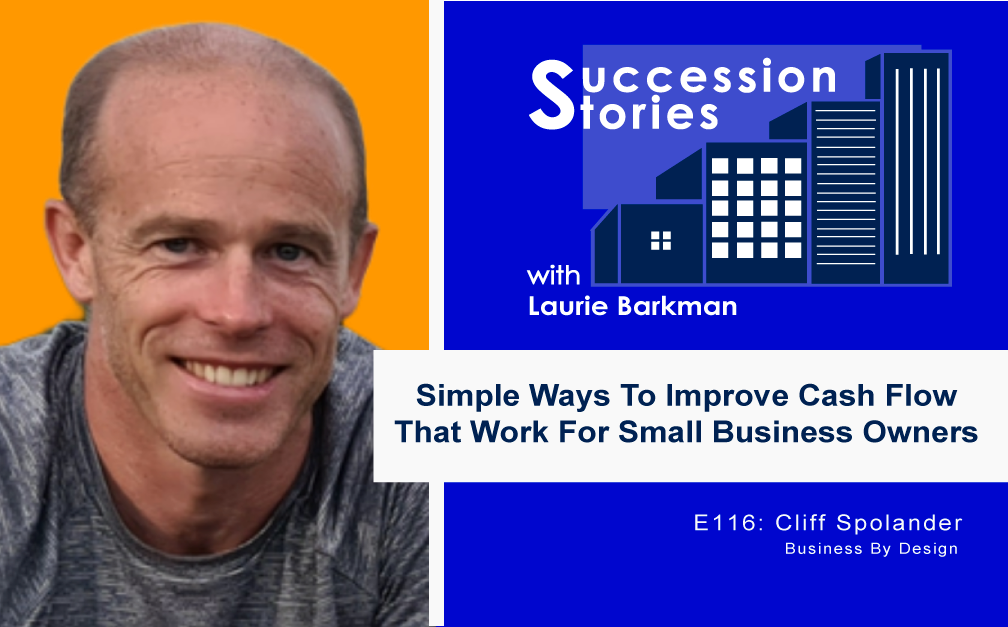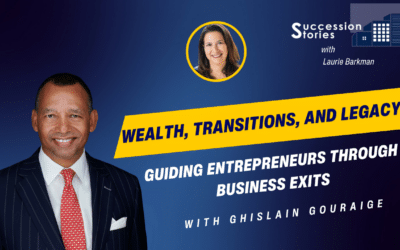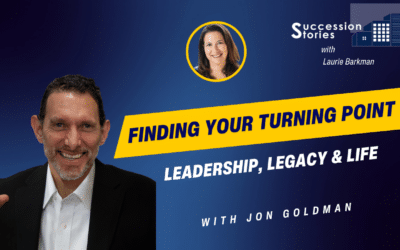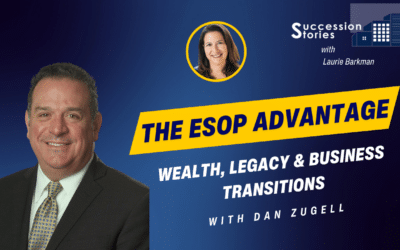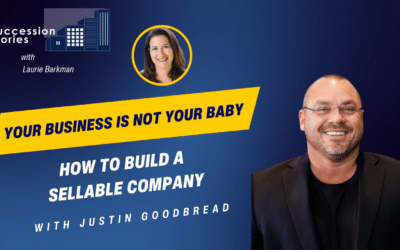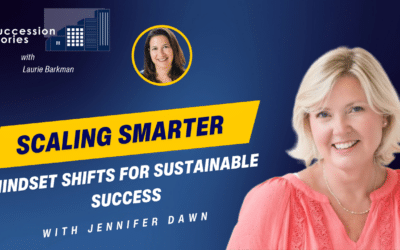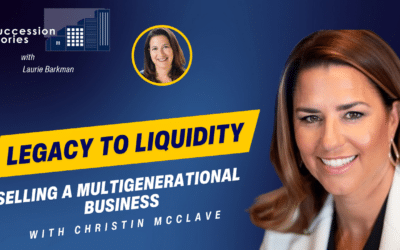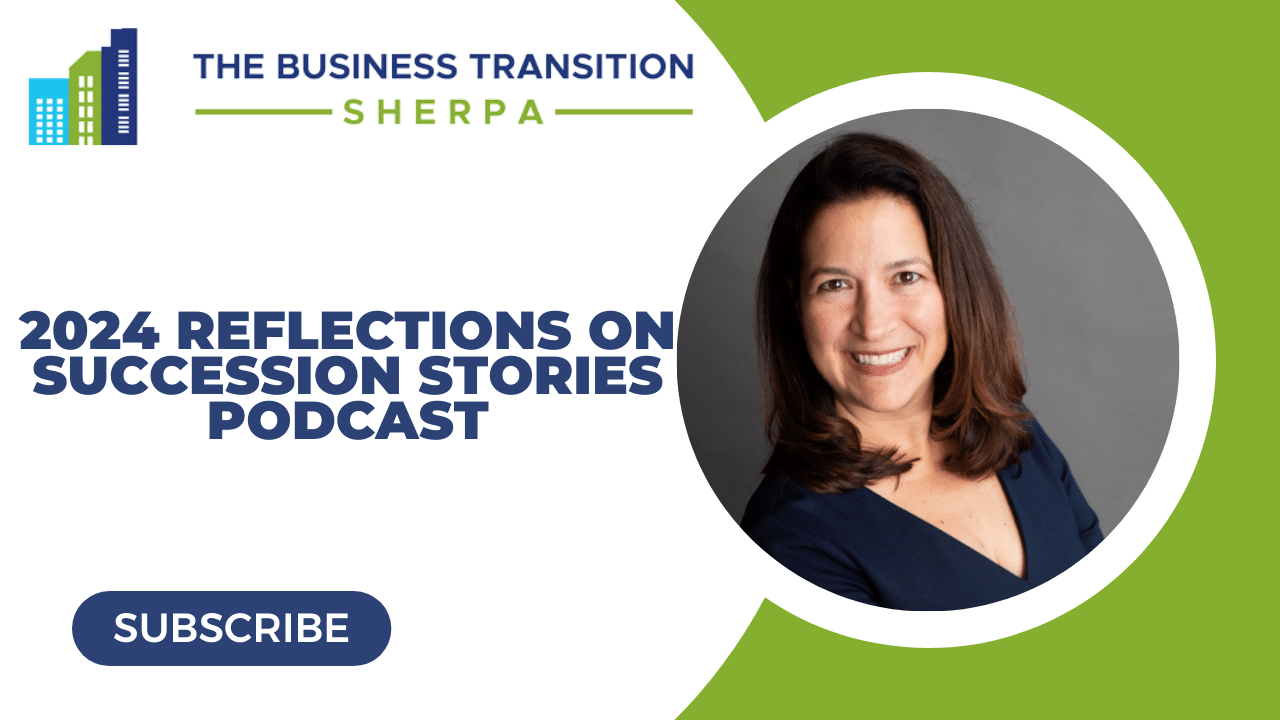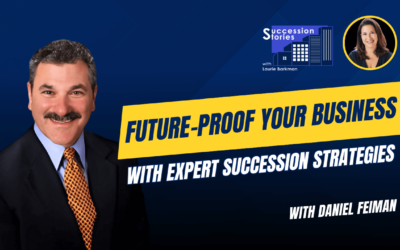When it comes to evaluating the risk profile of a business, buyers look at the potential pitfalls starting with cash flow. Cliff Spolander, author of The Cash Flow Code, is the CEO of Business By Design, an exit planning advisory company in the UK. He has started, bought and sold several companies across a range of sectors including retail, education, health and construction. Cliff helps business owners strike a balance between protecting cash flow and profit margins, while growing their business. Laurie Barkman talks with Cliff about the importance of improving cash flow as a key step towards getting your business exit-ready and creating the transferable value that every buyer is seeking. Enjoy this Succession Stories episode to help you improve cash flow and reduce risk in your business with Cliff Spolander.
Listen in to learn more about:
- Going with a strategic vs private investor
- Developing strong business foundations
- Terms and tools to improve cash flow
- Benefits of cash flow statements & forecasts in M&A
- Assessing risks, developing a risk profile, and concerted risk mitigation
- The value of documentation, systems and processes to potential buyers
Show links:
Cliff Spolander on Linkedin: www.linkedin.com/in/cliffspolander/
Website: www.businessbydesign.co.uk
The Smarter SCALE-UP: https://www.thesmarterscaleup.com/
Saleability Test: https://www.saleabilitytest.com/
Laurie Barkman on LinkedIn: https://www.linkedin.com/in/lauriebarkman/
Subscribe on YouTube: Succession Stories YouTube Channel
About Succession Stories Podcast
Succession Stories is an award-winning podcast guiding entrepreneurs from transition to transaction. Hosted by Laurie Barkman, author of “The Business Transition Handbook: How to Avoid Transition Pitfalls and Create Valuable Exit Options.”
Get your copy at: www.theBusinessTransitionHandbook.com
Learn more about strategic business transition planning at https://thebusinesstransitionsherpa.com
SHOW SPONSOR: STONY HILL ADVISORS
Stony Hill Advisors works with owners like you to get ready and maximize value when you’re ready to sell.
Visit www.stonyhilladvisors.com/podcast for a complimentary business valuation.
Transcript
Intro:
When it comes to evaluating the risk profile of a business, buyers look at the potential pitfalls starting with cash flow. Cliff Spolander, author of The Cash Flow Code, is the CEO of Business By Design, an exit planning advisory company in the UK. He has started, bought and sold several companies across a range of sectors including retail, education, health and construction. Cliff helps business owners strike a balance between protecting cash flow and profit margins, while growing their business. We talked about the importance of improving cash flow as a key step towards getting your business exit-ready and creating the transferable value that every buyer is seeking. Enjoy this Succession Stories episode to help you improve cash flow and reduce risk in your business with Cliff Spolander.
Laurie Barkman:
Cliff Spolander, welcome to Succession Stories. I’m excited to be with you today.
Cliff Spolander:
Thanks, Laurie. Thanks for having me.
Laurie Barkman:
Absolutely. You and I have been trying to get this on the calendar for a while. I think we met, oh, my goodness, probably six months ago online in the how to exit networking group that our mutual friend Ron Skelton hosts and I thought, “Aha, we are kindred spirits,” because you’re passionate about Exit Planning. You talk with a lot of business owners about how to get ready to talk about good business strategy. Those are all themes that we talked about here on this show and I, of course, talk with my clients about and ultimately, I think we share that same mission of how do we help business owners and this long trajectory of the journey that they’re on, which is to build their business, and then ultimately letting go, So again, welcome. Why don’t we start with you? Why don’t you tell me your story?
Cliff Spolander:
Well, I grew up in South Africa, I then left school, I joined the South African Navy, studied electronic engineering, but always had been fascinated by business. I think I always wanted to have my own business at some point and then I left South Africa, moved to the UK, that was the end of 2000, and that’s when I really began my kind of journey into business. Over the years, I have started and bought four companies. I franchised one and licensed another in five countries. I’ve had my successes, I’ve had my failures, I’ve made mistakes, and I’ve made some good decisions as well so I appreciate the journey of being in business is a tricky one, it’s a difficult one, but it’s also at the same time, very rewarding. That’s why I’m so passionate about helping other people kind of not make the same mistakes, or repeat the same mistakes I’ve made. That’s why I wrote the two books I have. It is just to really help people understand the basics around finances around cash flow, and then also how to strategically grow and also to exit the companies so through all of these trials and tribulations that I’ve been through, I want to share that with fellow entrepreneurs that they can hopefully learn from my mistakes and progress further quicker than what I have.
Laurie Barkman:
Yeah, absolutely. Well, tell us a little bit about your entrepreneurial experience. You summarized, and it’s very intriguing to say, in one sentence – built and sold four, franchised one, and that sounds like an easy check the box and I know it is not an easy check the box, the companies that you built and sold. Why don’t we start there?
Cliff Spolander:
I think initially, I didn’t intend to sell it. For me, it was the need to start this company. At the time I was in my early 20s so I was very wet behind the years, my understanding of business was very limited so I thought let me start a business. In my head I was gonna keep it, build it, scale it, and then kind of put people in place and they’d run the business on my behalf. With anything and everything I did, every company that I took on whether started or bought, I always thought or looked at where I could get or how I get myself out of the day to day operations, whether that is through systems, operations, through bringing people in, I always looked to kind of get myself out so that I can spend the time doing things I enjoy doing, which at the time was paragliding and doing stuff as you do in your early 20s but also looking further ahead, once I have children and things like that to spend time with my kids, if they want to go and have a school assembly or sports day, I want to be able to go in and enjoy and watch them do that so I always look to use business as a as a vehicle to get me to where I want to go.
Only as time went on did I realize that certain businesses in certain sectors either are just pure lifestyle businesses, whereby they will give you the lifestyle you want, but it will require and will impact you in some sort of way be it stress or having to work extra hours where you need to or some sort of issue with other companies so you can easily scale but then you’ve got scaling problems and so I realized very quickly that not all businesses are the same. There are different types of businesses, different types of sectors and so I learned pretty much in my first 10 years that I needed to look at and pick the right ones. I was in business with some family members that didn’t go well so I learned not to go into business with family and friends. I was also very trusting. With people, I learned not to be trusted because you get unfortunately screwed over so I’ve learned that just proving on paper makes sure both parties or the parties understand the concepts of what’s required of everyone. Through one to one or franchise, yes, it took us a long time to get the processes right, you have to do it yourself, figure it out, make the mistakes, improve the systems operations, test it out, make sure it works for someone else, and replicate those results and so it’s just really about getting into the nitty gritty of everything.
A demolition business I bought back in 2014, I knew nothing about demolition, I never set foot on a building site in my life so I haven’t got a clue what some of the tools were but I knew that if I learned quickly, I could figure things out so for the first six months, I was on site, watching the guys working with my foreman, understanding how to do things and I could prove very quickly figure out repetitive tasks that I could systemize and so I went away from that and for about two months, just literally working from my computer, creating those systems, those procedures, give it to go from a form and give it to my contract manager to read, redo, look at, improve, and that saved them time that made them more efficient, which means I could grow the team so it’s a learning curve that I had to go through and every business has that learning curve where you see what can you do to improve it and then once you create this as an awesome, test the system out, make sure it all works. There’s all these little bits and pieces that you can plug on as you go along and a pretty key thing is cash flow and without cash flow, you don’t have a business so making sure you’ve got good credit control systems, making sure that your company is working as efficiently as possible before you start to grow the business. When you grow the business with weak foundations, it could cause the company to collapse so always little things I’ve kind of played around with and dodged a few bullets and learned from my mistakes.
Laurie Barkman:
Absolutely and so the different types of companies, just curious, you mentioned one is demolition, what were the others? And then did you buy them? Or did you build them?
Cliff Spolander:
The one I started was retail, then that was franchised. The other was education, bought into that, and then sold that. The other was construction with the demolition business, and the other was health so we were able to create a formula and software with a heart rate monitor to work out how risk adverse or how close you were to either having a heart attack or stroke based upon how stiff the arteries work so we can then kind of give you a bit of a early warning system to say hey, “You know, the arteries are slightly stiff or clogged, you need to start, either go to your GP or your doctor and get things sorted out or change your lifestyle.” So it’s in the health and medical side of things so those are the sectors.
Laurie Barkman:
Did they all sell to strategics?
Cliff Spolander:
No, the one that I licensed to in five countries. That was one of my mistakes; being too trusting with my business partner who did the dirty on me so I had to pretty much close the business down and just learn from my mistakes there so that one unfortunately was a mistake, lesson learned. Sold the education, sold the retail which are franchised, sold the demolition, and I sold a web company.
Laurie Barkman:
And what did they sell? They sold to other individual entrepreneurs, or did they sell to larger companies?
Cliff Spolander:
To individuals mainly, that’s the widest scope, you can go for strategic but also with strategic come positives, negatives, they typically have a slightly bigger checkbook but then they also will look at your business and tear it apart and some of your employees will go where a private investor or individual will tend to look after the business in a more holistic way the same way you would you and I would look after it so I went down that route.
Laurie Barkman:
You have experience in building and selling and franchising as we’ve talked about and one of the key aspects of what I see, when there’s a potential acquirer, one of the first things they want to know about is the financials and they want to know about the cash flow of the business, especially for acquisition entrepreneurs, and we can talk about these people who are more financial buyers and strategic right, let’s sort of characterize them a little bit. Maybe this is their first time buying a company, maybe it isn’t and they might be seeking an SBA loan or they might have other sources of funding either through financial backers or perhaps they’re rolling over some money from a different transaction that they’ve done so they’re self-funding. What other characteristics might you might we might we say, for acquisition entrepreneurs from your experience?
Cliff Spolander:
Yeah, financial is always a big one. It’s one of my biggest headaches, especially with the small medium size kind of companies, they tend to only give you the P&L profit and loss and the balance sheet and when it comes to the cash flow, there’s no cash flow forecast. There’s no cash flow statement so you don’t really understand the cash flow cycles. That’s one of my big biggest bugbears is we need to understand as as buyers, we want to see cash flow cycles, we want to see debtor days, creditor days, stock days, you want to see where in the year is your cash flow, the lowest where it’s the highest was at the level to determine when we acquire a company how much working capital we need in order to get through the downside. Having that visibility is very, very important.
The next is also having a risk profile, understanding where the risks are within the business and so I use some software that kind of gives you a very good overview of the business and gives it to you in a traffic light system where it’s red, amber, or green and you as the owner need to work through those areas to make sure that things are at least amber, but mostly green and you can back it up by having documentation, past policies, systems and procedures in place to do that. Having a kind of a combination of having good cash flow, good forecasting and also, when you have a forecast, how close is your performance against that forecast? There’s one thing saying that your company grows 20% year on year, but in real terms, actually, it grows 5% year on year so how closely aligned is your forecast versus your performance? But then risk. You know where we are the risk profiles in your business? Is it down to a choice of health and safety? Is it a band? Is an employee risk? Supplier, customer risk? Where does the risk lie and what are you doing about that risk that will reduce it which basically will which will ultimately make the company more sellable and more factors?
Laurie Barkman:
Yeah, absolutely. There’s a lot of things you just talked about there but the main three things we can always boil it down to is how attractive is the business? How transferable is it and essentially, what are those aspects of risk and how do we mitigate those things?
Let’s talk about cash flow. You’ve written a book on it, you’ve written it for business owners, right? The main audience is business owners. Tell me about what you learned along the way about the sequential. A few things here with forecasting, but I’ve met a lot of business owners in this small to medium sized market and they don’t have CFOs, they maybe have a bookkeeper in house or there are outsourcing they’ve thought about a fractional CFO, if they don’t want to have a full time CFO in the team and so what I see is that they have a pretty good use of a tool like QuickBooks. in America, we use QuickBooks, I’m not sure if there’s an equivalent in the UK, that’s quite common and then the accounting firm has access to it, is managing on their behalf and so if the bookkeeper is doing a good job at putting things in the right category, then the accounting firm is running a report or the business owner is pushing a button and getting a monthly P&L, and maybe they’re looking at their balance sheet, maybe but I don’t see that a lot of them are looking at a statement of cash flows. One of my clients recently said, “I don’t even know what that is,” they’re just not familiar so maybe we can hear – let’s just do kind of a one on one of what does cash flow mean? What is working capital? Why is it important, and when a buyer is looking at the business, what is that context of why they care? You mentioned a few reasons already but let’s just take a deeper dive.
Cliff Spolander:
That’s good. Good point. I think the reason why I wrote the book was, in one of the companies that I had, we were profitable, and we’re doing our quarterly accounts but the cash flow was always a problem for us. It never seemed to work. I was always fighting, keep ahead of water. We always know we’re in the red and the black, red, the black is that roller coaster cycle that you tend to have with cash flow and so I said to my accountant, “Look, I don’t quite understand, we’re profitable but why am I always struggling for cash?” And you said to me, “Wll, it’s quite simple. Just grow the business. The more sales you make, the more profit you make, the more cash flow you have,” and at the time, that made complete sense so that’s what I did. I grew the company by 20% and you find that I was in a worse position than I was before. I had less cash and then I had to pay suppliers. I had to pay my employees, didn’t have any money and that was a turning point for me.
At that point, I decided I needed to pack it in and just get a job somewhere else or I needed to really understand how cash flow works. What is cash flow? What does it mean? Is this not profit and how does it work? How does it function? So the book that I wrote is really to help owners understand exactly what cash flow is, how it fits into the business and what it looks like and along with that, I’ve created a cash flow simulator so that will tell you what your cash position will be like in 12 months time based upon your current set of accounts so if you were to grow your business, they will show you if you do grow your business, are you still solvent? Will you still have cash in the bank or won’t you, and I found in that business in that particular business that actually I had a huge credit control problem. I thought my clients were paying me on 35 day terms. In actual fact, that database was showing 60 plus days, where I was paying suppliers on time, I had a massive cash gap. When you grow the business, and of course, most of the business that I grew was b2b, b2c, also b2b, they tend to drag our payments, so that created a bigger cash gap, which means which created the cash problem so what I did go back to first principles was to look at what my, my credit control system looked like, beef that up, make sure that my desert days were between 30 and 35 days, not to 65 days, and then grow the business.
Within that, within the cash flow, I call them the six keys to cash flow, and there’s an order in which you do things and the first critical key is the database. Make sure your credit control system works. Make sure that you know what your debtor days are, if you think it is 30 days, or are they really 30 days, or they are 45, 60, 90 days. Next is your credit so your accounts payable, where you pay suppliers, you can pay early if you want to, but pay them on time and if you can negotiate terms, but you can pay them slightly later. Or maybe use a credit card where you pay now, but you only pay the credit card 45 days later, right and close that gap as much as possible. We will because it’s a retail business we had stocked and we had lots of dead stock sitting on our shelves, which meant we had lots of getting money sitting on the shelves so we got rid of all of that and then we looked at cost of sales, could we negotiate with the suppliers to reduce the prices by either buying in bulk or changing suppliers. Then we looked at expenses – where we were always spending our money and we looked at the ways we were spending money that we didn’t have to spend. We found them at around three to 5% with the savings just on that and just doing those five keys, your day to day is credit, stock days, your cost of sales, and your expenses, just you can you can exponentially grow your cash flow and profit just by doing that and then at the end of six key is to grow the business so those are the six keys to cash flow. In terms of due diligence, I think that is another big one. Buyers want to see a credible knowledge of systems and processes and documentation within the business to make sure that everything there is correct and up to date. You don’t want to see leases that are about to expire in two years time or any health and safety issues that crop up, so making sure your documentation is all there so what was your other question?
Laurie Barkman:
No, I think that’s great. I think that’s a great illustration. I’ve had other guests on the show where we’ve talked about the catch 22 of growth. I just wanted to double back on that point where your accountant said, “Oh, just grow, it’ll make it easier,” and I had a feeling that you’re going to tell me the story you did, which is because if you didn’t, I was gonna really probe on it like, “Oh, my God, that usually doesn’t work out very well. That worked for you, just grow more.” It’s too bad that you had to learn by trial by fire but it’s good that your business did stay solvent.
I do find that people who run small businesses, owners do not do forecasting and I’m not sure what the root issue is, why they don’t. I end up working with my clients to do it with them. I’ll kind of take a first pass and I’ll say, “How does this look?” I’m not doing anything magic. I’m looking at their historical, I’ll look at last year same time periods. Look at quarter to quarter month by month variations. We’ll look at year over year. Look at how they’ve been trending. Okay, we make educated guesses, so if I can do it, and I don’t know their business as well, why aren’t they doing it?
Cliff Spolander:
I think the honest answer is they didn’t know how to and, b), they are too scared to. Even on a personal level, I have a personal cash flow budget xo I know how much money I spend on food every month on clothes and things like that so I can look at, as my kids are growing and getting older, they’re eating more so I know my food bills’ increasing, my clothes bills increasing, the activities are increasing so I can forecast and budget for next year. Speaking with friends, I say, “Do you have a personal budget?” They go? “No, no, I wouldn’t touch that because I don’t want to know,” and when the money at the bank’s at zero then I stop spending until money comes back in again. I think with owners, I think for some reason they either spreadsheet, so financial reporting seems to scare them a bit but also, I think it also shows them that it’s making them realize where they are and what they need to take action on, I think it’s much easier to kind of bury your head in the sand and ignore it and hopefully the problem will go away. Whereas the looking at the cash flow, you realize where your money’s going and sometimes it’s quite scary, because you think, actually, if I continue down this road, I’m going to be in serious trouble and some people don’t actually want to know about that until it’s too late.
Laurie Barkman:
Right, and the alternatives are borrow, you’ve got to borrow money from the bank, maybe get a line of credit. That’s one way to solve the gap. The other thing that you shared were the diagnostics of, okay, let’s look at, here we say average days, sales outstanding so, the terminology might be a little different if people were familiar with some of the accounting and just calling that out for our folks but otherwise, it’s basically money in money out and what is the timing of that? That’s critical. We do it with our own bank accounts, you can’t be overdrawn. Same in your business.
I lead an executive workshop I do this workshop with, I’ve done it with hundreds of business owners across the states over the last year plus, and one of the exercises I have them do is a brainstorm on. Okay, let’s talk about money. What can we do differently to bring money into the business sooner? Basically one of the first things you said, right, let’s just sort of shore that up and I’ve brainstormed gosh, I mean, we had a couple of flip charts worth of ideas, all different kinds of companies and there’s no one answer. The answer sort of lies within the particulars of your business. You’ve worked in construction, you had education, you had retail. Now, obviously, if you own the inventory, that’s a whole other thing and I can relate to that. We used to say we have bananas, not fine wine, we got to keep it moving and let’s just kind of go back to that a little bit.
Maybe we’ll just do a little virtual exercise here so if people are listening, and they’re thinking about this, step one is just take a fresh look at your policy. What are the payment terms? Or what is the ask that you’re making of your clients, let’s say it’s a services business. I have an example here, too. I can just share the high level, a client is roughly a million dollars in revenue top line so it’s a small business, they have small team projects, not an ongoing retainer, but project business. Their policy was when they would invoice they would invoice and it would be kind of in stages when services were rendered and then I think the client had 60 days, so they would not be paid for what they’ve delivered for it could be, four months, or longer so the very simple question I asked was, “Well, what are your policies? When’s the last time you looked at it? And is anything changeable?” And he said, “Well, that’s a great idea,” and he looked at it, he goes, “Yeah, you know, there’s no reason we can’t ask for some money up front and maybe we should start to think about the business model and what can we do to have more monthly income coming in,” as opposed to what they were experiencing was a little more quarterly and that was step one, “For any new client we’re going to put in some new terms and now for my existing clients, I’m going to do it gradually and I’m going to be careful about it because I don’t want to shock the system too much. I’ve got to work with these existing.” I thought that was a great illustration. I do share that because it’s just so simple, right, it’s something you can control. What is another thing that you might say that you’ve just helped open people’s eyes to?
Cliff Spolander:
I had that same issue with the construction business. The demolition. I think the average debtor days in that sector was 72 and minus 28 and this is just a simple reframe, we say, “Look, if it’s a big project, we do it in stages, so we hit certain milestones or offer a monthly invoice to you.” Our terms were 14 days, but we knew we were going to be chasing so within that we went through that we’re happy with the amount we’re invoicing. We then followed up with a phone call, did they receive the invoice? “Yes, we did.” Another phone call five days before, “Is the invoice on your system? Are we due to get paid in five days?” On the day it was meant to be paid, we phoned them again, and then if it was late, we kept phoning and phoning and phoning so they’re always front of mind but it’s also a bit of a reframe.
For new customers, we’re saying that if you want us to do the best work possible we knew we could pay our people, we got to pay our suppliers and things like that so for us do the best work for you all, I ask that you pay us on time, because that’s at least what you would expect from someone from your customers and you just have a very frank and open conversation. I think people understand that they, too, have customers and they too have suppliers and they have the same issue as you and I think it’s only fair that if you my client expects to get paid on time, then they should also pay me on time so it’s about having that open conversation and a slight reframe and so that’s why I got out every day today down from 72, which is the industry standard to 28, just by having the upfront payment stage payments, milestone payments, constantly chasing, but also saying, “If you want us to help you, then help us.”
Sometimes we offer a bit of a discount, maybe we hiked the price up a little bit and said, “Look, if you pay early, we’ll give you a 5% discount,” so it goes up real discounting, but it’s for them and seem to discount so we use that as a tactic as well and we returned up front and make sure that happens but we’re also very careful of who we work with as well so if you know people are going to and we’ve had a few occasions where one company did go bust, but we just managed to get the money out of them just before they went bust. We don’t work with those kinds of companies. We do a bit of a credit check behind the scenes to make sure that they are legit and liable and they do pay on time but yet, it’s checking the client history on a credit report I don’t know what you have in the States, we can check the credit status of the client, but also having an open conversation with them and just reframing it and just being open, honest, “This is what we did. These are our policies, this is how we work and if you don’t like it, then unfortunately, we can’t help you,” and just be very strong and strict about that.
Laurie Barkman:
Well, the other thing that you mentioned, which is something again, a business can control is having a person or team accountable for accounts receivable and even in big companies, it’s amazing how that just can get missed so in small companies, an owner who’s busy and has a lot of things going on, he or she isn’t going to necessarily want to be chasing the dollars. Did you do that yourself? Or did you have a team or did you outsource it?
Cliff Spolander:
Bit of both. Then I had my contract manager do most of the chasing but just before I left the business in mid 2019, some really neat software was coming on the market, which kind of did lead chasing work for you so basically put in the set emails and a set times or when they should be going out I think you did in Xero as well, we can automate it or basically you can set the software to do the check in for you and a chasing for you so ended up being him doing most of it and then merging it into the software doing most of the heavy lifting and if they were really weren’t paying on time, he would then make the phone call but the software did the the big lifting and nowadays, you can get some really great pieces of software that does it all for you and you can even get companies out there to do it on your behalf and they charge a small fee so even if you can’t afford to employ someone and you’re too busy, get these companies out there to do it for you and for a small fee so there’s so many options out there now. It’s crazy.
Laurie Barkman:
The flip side of this, we talked about getting money in sooner, the flip side is money out later and one of the things is then what we can call vendor financing, which is asking your vendors for terms, right? Why can’t you ask for 60 days, 90 days, we had that experience. I was in a big company so it meant millions of dollars to us when our partner agreed to terms it was, again just one of those no brainers like “Why hadn’t we asked previously?” It just took a simple question.
Cliff Spolander:
Yep. Again, I always encourage my clients to speak with their suppliers every six months, at least once a year, but also have the information in front so look I spent X 1000s of dollars with you. I may be a small company in your eyes, but I still spend 10, 20, 30, whatever $1,000 with you, can we agree terms? Either give me a slight discount on what I’m buying, or increase my payment terms, from 30 days to 45 days to 60 days and have those conversations and more than likely they, if you’ve been paying them on time regularly and they know and trust you, then they tend to want to help you as well so having the conversation’s quite easy. Another way of doing it is get, I don’t know how it works in the States, but here in the UK, you can get a business credit card where if I buy something on and say the first of December on the credit card that only comes out of the card, out of my bank account, at the end of end of Jan so I’ve almost got two months worth of space there as well so you’re stretched further by using credit cards, and paying the supplier on time effectively, but then you’re only realizing that cash out two months later so you can even stretch it out even further so there are many ways of doing it.
Laurie Barkman:
Yeah, absolutely. You’ve shared so much with us. I know people want to know how to find you and learn more from you and you’ve got a lot of resources available so Cliff, how can people reach out and discover more?
Cliff Spolander:
I’ve got three main websites, two of them are tool websites and then one’s my main website. The main website is businessbydesign.co.uk and then I’ve got two tools that people are more welcome to use and to play with. The first one is thestabilitytest.com and the second is the smartestscaler.com and they have various tools on there free of charge to use business valuation as a suitability or your exit ready, your cash flow simulator, all the tools are there for you to to use free of charge.
Laurie Barkman:
Awesome. I know you’ve probably got a million quotes and you’ve written a couple books so you’ve probably got a few quips of your own. Is there any quote that really inspires you as an entrepreneur, inspires others?
Cliff Spolander:
I think it’s the saying here, ‘Exit Planning is simply good business strategy’. With Exit Planning people think of selling or exiting the business but actually, Exit Planning is just a way of growing a business that allows you and gives you choices for the future is all Exit Planning is so my favorite quote is that quote is Exit Planning is simply good business strategy and good business strategy is simply how you scale the business to give you the freedom to give you the choices that you want.
Laurie Barkman:
Yeah, absolutely. I love that quote and I couldn’t agree more as we put a kind of a bow on this conversation, and we want to leave people with three things that they might think about for their business, and it could be cashflow specific/related as we’ve been talking about, or it could be anything, what would be those three things?
Cliff Spolander:
I think one is cash flow. I think it’s looking at your six keys. Look at your day, your money in money out and how much money is on your shelves, doing nothing? Can you get rid of that very quickly? Look at your cost of sales, your expenses, then look at growing your business so that’s cash flow, then on selling and exiting, prepare for that. We don’t know what the future holds so always look to get yourself out of the day to day running the business as much as possible either by using software systems, processes, or get people in there as well and thirdly, prepare for the due diligence phase, get your risk analysis done, look at your look at your leases, get your health and safety permanent, get your HR, your Human Resources correct and all that kind of stuff if the risk profile of your company and looking at those three things, I think you will know even though business is a bumpy has a bumpy ride at times. I think looking at those free cash flow, due diligence to risk profile and the DD preparation. I think that is what really will help a lot of people.
Laurie Barkman:
Cliff, thank you so much for coming on Succession Stories. I know we could talk for hours. We have so much to probe in your background and also all the knowledge that you’ve gained and in coaching entrepreneurs and helping them be successful so thanks so much for coming on today.
Cliff Spolander:
Thanks for having me.
Laurie Barkman:
Listeners, thank you so much for your support. Catch Succession Stories on your favorite podcast player or YouTube, and subscribe to the show! If you want to maximize the value of your business and plan for future transition, reach out to me for a complimentary assessment at meetlauriebarkman.com. Join me next time for more insights from transition to transaction. Until then…here’s to your success.

